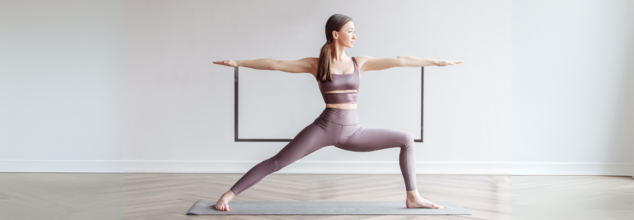- Health Conditions A-Z
- Health & Wellness
- Nutrition
- Fitness
- Health News
- Ayurveda
- Videos
- Medicine A-Z
- Parenting
- Web Stories
8 Balancing Yoga Poses That Can Help You Build Your Co-Ordination And Flexibility

Many people falsely believe yoga poses are just meant to make you comfortable and flexible, they think it is something one only needs to do if they wish to calm down. However, it is so much more than that. If done properly, it can change the way you live life. Whether it is making yourself more balanced, more flexible, losing weight, or being stronger.
Yoga is way more than just stretching. It's a powerful way to bring your mind and body closer, offering real benefits that can change your everyday life. If you want to get healthier, calm your thoughts, or just feel more connected to yourself, yoga gives you a full-picture way to feel good. It can make you stronger, more flexible, and more balanced, all while helping you handle stress and boost your overall mood.
Why Balancing Yoga Poses?
Balancing yoga poses do much more than just challenge your stability; they actively improve your overall health and well-being. These powerful poses work wonders by making your body stronger and more stable, especially in your core, legs, and ankles.
Balancing yoga poses also sharpen your mind. You'll notice better focus and less stress as you learn to center yourself in each pose. By always adjusting to stay steady, you become much more aware of your body's position. This leads to smoother movements and fewer stumbles in your daily life. Basically, balancing yoga helps you become stronger, more coordinated, and more aware of yourself.
Eagle Pose
This pose challenges your balance by wrapping one leg around the other and crossing your arms. It deeply stretches your shoulders and upper back while strengthening your core for better stability.
Extended Hand-to-Big-Toe Pose
Standing on one leg, you extend the other forward, holding your big toe. This pose significantly improves your hamstring flexibility and core strength, while challenging your standing leg's stability and enhancing mental concentration for better balance.
Half Moon Pose
From a standing position, you extend one arm and the opposite leg out to the sides, forming a "T" shape. This pose beautifully opens the hips and chest, strengthens the core, and dramatically improves your sense of balance and spatial awareness.
Handstand
Practiced against a wall or free-standing, this inversion builds immense upper body and core strength. It demands intense focus and body awareness, fundamentally improving your balance by challenging your perception of alignment and stability upside down.
Lord of the Dance Pose
Standing on one leg, you reach back to grasp the foot of your lifted leg, extending it upwards like an archer's bow. This deep backbend and hip opener demands significant balance and concentration, while also increasing spinal flexibility and leg strength.
Side-Plank Pose
Supported on one hand and the side of one foot, your body forms a straight line. This powerful pose deeply strengthens your core, obliques, and arms. It's a fantastic way to build stability through your entire side body, crucial for coordination.
Side-Reclining Leg Life
Lying on your side, you lift your top leg straight up towards the ceiling. While seemingly simple, this pose strengthens your outer hip and thigh muscles, crucial for walking stability and balance. It gently improves flexibility without high impact.
Warrior 3 Pose
Standing on one leg, you extend your torso forward and the other leg straight back, forming a "T" shape parallel to the floor. This dynamic pose strengthens your entire leg and core, while intensely challenging your balance and building focused determination.
Fat Loss And Strength Gaining Made Easier With This Change In Workout Order

(Credit-Canva)
Should you do cardio or weights first? All gym goers have been faced with this choice one too many times. Some prefer doing weights before they hit the cardio machines, while others try to get over it before. But is there a better option of the two?
New research suggests you might want to hit the weight room before you hop on the treadmill, bike, or elliptical.
A study published in April in the Journal of Exercise Science and Fitness investigated how the order of cardio and resistance training might impact health and fitness. The findings showed that participants who did strength training before cardio had "remarkable progress" in physical activity, fat loss, and muscular strength and endurance.
But does this mean lifting weights before cardio is always the optimal choice?
What Happens When You Do Cardio After Weights, and Vice Versa?
In the study, researchers had a group of young men who were overweight or obese try different workout orders. They split the men into three groups:
- One group lifted weights, then did cardio.
- Another group did cardio, then lifted weights.
- The third group didn't do any structured exercise.
The groups that exercised worked out three times a week for an hour each session, over three months. Both exercise groups did 30 minutes of cardio and 30 minutes of strength training; only the order was different. Experts noted that a good point of the study was that both groups followed the same workout plan, which helped keep things fair.
Before, during, and after the study, researchers checked everyone's activity levels, body fat, muscle strength, and heart fitness. The results showed that both exercise groups improved in:
- How active they were
- Their body composition (less fat, more muscle)
- Muscle strength
- Heart and lung fitness
These results suggest that lifting weights before cardio is the best if you want to improve these specific things. However, a point noted was that the group that did cardio first still saw "very good" improvements that are good for health.
How Your Workout Order Affects Your Body
Generally, the order of your workout matters because of how each type of exercise makes you tired. Doing cardio first can make you tired, meaning you might not have enough energy to put your full effort into lifting weights. Research supports this, showing that intense cardio before weights can reduce your strength endurance.
When you lift weights first, you're likely able to do your strength training with your best energy and focus. This might explain why the group that lifted weights first in the study spent more time training at higher intensities. This order could be ideal for people looking to build muscle or lose weight.
However, doing cardio before lifting weights also has benefits, especially if you're trying to improve your cardio endurance and heart and lung health. It allows you to put your best effort into your cardio sessions, which can be helpful if that's something you struggle with.
Building the Best Workout Routine for You
When planning your workouts, think about your main goals. Start with whichever type of exercise—strength or cardio—you want to prioritize and improve the most. Just make sure you don't skip either type of training. Both are important for improving your health and fitness and should be a regular part of your exercise routine.
Also, changing up your workout order occasionally can help your body adapt to new challenges, further improving both muscle and heart fitness. Ultimately, remember that simply doing either cardio or weight training will help you improve muscle strength, bone density, heart endurance, and fat loss.
Most people prefer to lift weights followed by cardio, and more studies support the benefits of this order. But the most important thing is to find what works for you, and the health benefits will follow.
UK-based Reporter Tried The One Exercise Loved By Meghan Markle, Kardashians, And Hailey Bieber - Here's How It Went For Her

Credits: Wikimedia Commons and Instagram
Lagree Pilates has fast become the go-to workout for Hollywood A-listers, drawing the likes of Meghan Markle, Kim and Khloe Kardashian, and Hailey Bieber. Touted as a game-changer in strength and endurance training, Lagree combines elements of traditional Pilates with high-intensity, low-impact resistance exercises. Unlike the more familiar Reformer bed used in standard Pilates, Lagree is performed on a Megaformer—a machine specifically designed to target core strength, muscular endurance, balance, and flexibility all at once.
While the Megaformer has yet to become mainstream across all UK cities, Re:Sculpt studios in Manchester’s Ancoats and Salford offer a close alternative: the Maxformer, reports the Express UK. These machines mimic the design and intensity of Lagree’s original equipment, and their popularity is catching on quickly among fitness enthusiasts.
The Workout: More Sweat, Less Impact
Lagree Pilates sets itself apart by fusing strength training with cardio and balance-focused movements in a continuous flow, meaning minimal rest and maximum burn. It's often described as the “next level” of Pilates—great for building lean muscle, especially in the core, with little strain on joints. This makes it appealing not just for aesthetics but also for sustainable, long-term fitness.
The Experience: Pushing Past Limits
Isobel Pankhurst, a reporter with Express UK, decided to try the Maxformer class at Re:Sculpt’s Ancoats studio. Despite being no stranger to Reformer Pilates, she approached the session with caution. Upon arrival, she was greeted with a motivational quote—“So tough, but unreal!”—and a glass of citrus electrolytes, a detail that immediately made her second-guess her decision. After all, she’d never been handed electrolytes before a workout. What exactly was she in for?
The class, called Re:Tread, merges two formats: half the time on the Maxformer bed, and the other half on a treadmill. Each day alternates between focusing on upper or lower body, and Pankhurst’s visit landed her in an upper-body session.
The Maxformer, she quickly discovered, was not just a souped-up Reformer. It demanded far more in terms of strength and balance. The moves challenged her core and coordination, and even with prior Pilates experience, she found herself struggling. That said, the intensity also brought satisfaction. “It was so much more difficult than a Reformer,” she admitted, “but I did enjoy trying it out and will definitely return.”
The Treadmill Trials
After 20 sweat-drenched minutes on the Maxformer, the second half of the session moved to the treadmill. As someone who rarely runs—unless late for a train—Pankhurst dreaded this portion. “I’m not a fast runner,” she confessed, keeping her settings at a gentle jog while others sprinted full force. Still, she viewed it as a step above lazing in front of the TV and pushed through.
The Aftermath: Sore, but Satisfied
By the end of the hour-long session, she was wiped out and ready for a shower, but not before grabbing a protein shake to help recover. The next day came with the expected soreness, but also a sense of accomplishment. “It was tough,” she said, “but worth it. That quote of the month really was spot-on.”
So while the Maxformer may not be for the faint of heart, it’s certainly a full-body challenge worth considering—especially if you’re curious about what keeps Meghan and the Kardashians in shape.
Turns Out, Exercise Might Be the Most Underrated Cancer Drug But Could It Do More Harm Than Good?

Credits: Canva
As cancer care becomes increasingly scientific, there is one variable that remains an effective force in enhancing patient results: exercise. Though physical activity has been well established to prevent chronic illnesses like diabetes and cardiovascular disease for decades, recent studies add a fascinating page to the narrative—exercise can also lower cancer recurrence and improve survival in patients with cancer.
A randomized controlled trial, reported recently in the New England Journal of Medicine, has given the strongest evidence to date that formal exercise not only promotes general well-being but also is a key factor in recovery from cancer. Investigators tracked close to 900 patients from 55 cancer centers in six countries who had all been treated for stage III or high-risk stage II colon cancer.
Members were divided into two groups: one was given routine health education in terms of nutrition and exercise, while the second group participated in a formal exercise program under expert health coaches. The disparity in results between the two groups was dramatic.
With a median follow-up of eight years, the patients in the structured exercise group had 28% and 37% reduced risk of cancer relapse and death, respectively. Importantly, participants in this group also showed significant improvements in cardiovascular fitness, as assessed by six-minute walk distance and VO2 max, a measure of oxygen consumption during exercise.
This is the first randomized trial to confirm that exercise after cancer treatment significantly lowers the risk of recurrence and death," she said. "It validates what we’ve long suspected: movement is medicine, especially for cancer survivors.
Colon cancer, for example, recurs in approximately 30% of patients despite surgery and chemotherapy. Hitherto, common practice had mainly concentrated on medical interventions, relegating lifestyle changes to the sidelines. This research flips that approach on its head.
How Exercise Facilitates Cancer Recovery?
Exercise benefits for cancer patients go far beyond physical conditioning. Here's how:
Improved Immune Function: Sustained physical exercise enhances the immune system, allowing the body to more effectively recognize and destroy cancerous cells.
Hormonal Control: Exercise maintains hormones such as insulin and estrogen in balance, hormones which have a potential to develop and drive some cancers.
Inflammation Decreased: Long-term inflammation is an established cause of cancer development, and exercise reduces inflammation levels within the body.
Better Treatment Tolerance: Patients who stay physically active tend to cope better with chemotherapy and other treatments, with fewer side effects.
Mental Health Advantages: Exercise helps in reducing anxiety, depression, and fatigue—emotional and physical issues that are common among cancer patients.
Can Personalised Programs Make the Difference?
The supervised exercise program implemented in the trial was not one size fits all. It incorporated sessions that were supervised and regular consultation with a health coach. The coaching aspect enabled the program to be adapted to patient-specific needs and fitness levels.
"Having someone to guide and motivate makes a huge difference, especially for individuals recovering from something as taxing as cancer treatment," said Dr. Wen. "We’re not asking patients to run marathons, but even moderate exercise, when structured and consistent, can yield profound results."
This study lends impetus to the increasing trend that promotes lifestyle interventions in mainstream cancer treatment. A number of healthcare firms and wellness businesses are already using these results in their services. Cerula Care and Complement 1 are among the platforms that provide one-to-one coaching on exercise, nutrition, sleep, and mindfulness.
On the clinical side, firms such as Faeth Therapeutics are pushing it even further by adding pharmaceutical therapy to targeted nutrition designed to target cancer metabolism. Preliminary results indicate that these synergistic strategies might offer even better recurrence protection.
Another key area that the research brings to light is that of social support. Group fitness activity or support from coaches and peers improves compliance with treatment regimens and emotional well-being. With the psychological impact of cancer, mental health ought to be brought to the fore as part of the cure.
Is This A New Prescription for Patients?
So, what can patients learn from this study? First, discuss with your oncologist or primary care physician the inclusion of a structured exercise program in your recovery regimen. The program does not have to be extremely rigorous; professionalism and consistency are more important than intensity.
Second, don't wait until after treatment. Preparing for cancer treatment and even engaging in some exercise during treatment can help deliver cumulative benefits that enhance quality and life duration.
Greatly, keep in mind that this is only colon cancer. Researchers think that the benefits of formal exercise may be applied to many other kinds of cancer. Future research is already ongoing to investigate these larger applications.
The message is simple: exercise is not optional or merely "good advice." It's an integral part of cancer care, something that should be incorporated into treatment plans from the moment of diagnosis right through remission.
As more studies highlight the cancer-fighting power of movement, it's time for patients and healthcare professionals alike to put physical activity front and center as a major weapon against cancer. The future of oncology is not solely in the realm of medicine—it's in movement, as well.
Can Exercise Possibly Do More Harm Than Good for Cancer Patients?
Although formal exercise has undeniable benefits for many cancer survivors, it's not a solution for all. For patients receiving high-intensity treatments such as chemotherapy or radiation therapy, overexerting the body—particularly without medical supervision—can have adverse effects. Excessive strain can cause fatigue, immune compromise, or injury that might postpone treatment or compromise recovery. For patients with metastases to bone, some activities will enhance the risk of fracture. Cardiovascular or pulmonary restriction resulting from cancer or cancer treatment also implies that exercise will need to be prescribed with extreme caution.
Exercise is not automatically bad for you, but bad or unmonitored exercise can be. That is why interventions like the one presented in the recent trial matched patients with health coaches and tracked progress. It's not about hammering the gym—it's about safe and incremental movement tailored to health status.
In short, exercise is potent medicine, but as with any treatment, the dose and delivery are everything. Always get your care team's approval before beginning or intensifying a routine. Correctly done, the rewards far surpass the risks.
© 2024 Bennett, Coleman & Company Limited

